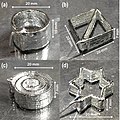Gallium
Gallium (chemical symbol: Ga) is element 31 on the periodic table. It is a soft, gray metal that is rare on Earth. It can easily be melted just by holding it in your hand, as its melting point is very low 29.76 Celsius (85.58 Fahrenheit), however it also sticks to your hand a lot, unlike mercury. Gallium is a semiconductor, and as the compound Gallium arsenide it is used in electronics and LEDs. Then, Gallium is also used in mirrors. Gallium can also be alloyed with indium and tin to create galinstan. Gallium is similar to the elements aluminium, indium, and mercury.[5] Gallium is also used to make alloys that are liquid at room temperature. These can be used as a thermal paste for computers, and as a substitute for mercury in some applications.
 | |||||||||||||||
| General properties | |||||||||||||||
|---|---|---|---|---|---|---|---|---|---|---|---|---|---|---|---|
| Pronunciation | /ˈɡæliəm/ | ||||||||||||||
| Appearance | silvery blue | ||||||||||||||
| Standard atomic weight (Ar, standard) | 69.723(1)[1] | ||||||||||||||
| Gallium in the periodic table | |||||||||||||||
| |||||||||||||||
| Atomic number (Z) | 31 | ||||||||||||||
| Group | group n/a | ||||||||||||||
| Period | period {{{period}}} | ||||||||||||||
| Block | [[{{{block}}}-block]] | ||||||||||||||
| Electron configuration | [Ar] 3d10 4s2 4p1 | ||||||||||||||
Electrons per shell | 2, 8, 18, 3 | ||||||||||||||
| Physical properties | |||||||||||||||
| Phase at STP | Ga: Solid | ||||||||||||||
| Melting point | 302.9146 K (29.7646 °C, 85.5763 °F) | ||||||||||||||
| Boiling point | 2673 K (2400 °C, 4352 °F)[2] | ||||||||||||||
| Density (near r.t.) | 5.91 g/cm3 | ||||||||||||||
| when liquid (at m.p.) | 6.095 g/cm3 | ||||||||||||||
| Heat of fusion | 5.59 kJ/mol | ||||||||||||||
| Heat of vaporization | 256 kJ/mol[2] | ||||||||||||||
| Molar heat capacity | 25.86 J/(mol·K) | ||||||||||||||
Vapor pressure
| |||||||||||||||
| Atomic properties | |||||||||||||||
| Oxidation states | −5, −4, −2, −1, +1, +2, +3[3] (an amphoteric oxide) | ||||||||||||||
| Electronegativity | Pauling scale: 1.81 | ||||||||||||||
| Ionization energies |
| ||||||||||||||
| Atomic radius | empirical: 135 pm | ||||||||||||||
| Covalent radius | 122±3 pm | ||||||||||||||
| Van der Waals radius | 187 pm | ||||||||||||||
| Spectral lines of gallium | |||||||||||||||
| Other properties | |||||||||||||||
| Natural occurrence | Ga: Primordial | ||||||||||||||
| Crystal structure | orthorhombic | ||||||||||||||
| Speed of sound thin rod | 2740 m/s (at 20 °C) | ||||||||||||||
| Thermal expansion | 18 µm/(m·K) (at 25 °C) | ||||||||||||||
| Thermal conductivity | 40.6 W/(m·K) | ||||||||||||||
| Electrical resistivity | 270 nΩ·m (at 20 °C) | ||||||||||||||
| Magnetic ordering | diamagnetic | ||||||||||||||
| Magnetic susceptibility | −21.6×10−6 cm3/mol (at 290 K)[4] | ||||||||||||||
| Young's modulus | 9.8 GPa | ||||||||||||||
| Poisson ratio | 0.47 | ||||||||||||||
| Mohs hardness | 1.5 | ||||||||||||||
| Brinell hardness | 56.8–68.7 MPa | ||||||||||||||
| CAS Number | 7440-55-3 | ||||||||||||||
| History | |||||||||||||||
| Naming | after Gallia (Latin for: France), homeland of the discoverer | ||||||||||||||
| Prediction | Dmitri Mendeleev (1871) | ||||||||||||||
| Discovery and first isolation | Lecoq de Boisbaudran (1875) | ||||||||||||||
| |||||||||||||||

Gallium's existence was predicted by Dmitri Mendeleev in 1871. Four years later, it was discovered by Paul-Émile Lecoq de Boisbaudran.[5]
Gallium Media
Small gallium droplets fusing together
Bauxite mine in Jamaica (1984)
Owing to their low melting points, gallium and its alloys can be shaped into various 3D forms using 3D printing and additive manufacturing.
Reference
- ↑ Meija, J.; Coplen, T. B.; Berglund, M.; Brand, W.A.; De Bièvre, P.; Gröning, M.; Holden, N.E.; Irrgeher, J.; Loss, R.D.; Walczyk, T.; Prohaska, T. (2016). "Atomic weights of the elements 2013 (IUPAC Technical Report)". Pure and Applied Chemistry. 88 (3): 265–91. doi:10.1515/pac-2015-0305.
{{cite journal}}: Unknown parameter|displayauthors=ignored (|display-authors=suggested) (help) - ↑ 2.0 2.1 Zhang Y; Evans JRG; Zhang S (2011). "Corrected Values for Boiling Points and Enthalpies of Vaporization of Elements in Handbooks". J. Chem. Eng. Data. 56 (2): 328–337. doi:10.1021/je1011086.
- ↑ Hofmann, Patrick (1997). Colture. Ein Programm zur interaktiven Visualisierung von Festkörperstrukturen sowie Synthese, Struktur und Eigenschaften von binären und ternären Alkali- und Erdalkalimetallgalliden (PDF) (in Deutsch). PhD Thesis, ETH Zurich. p. 72. doi:10.3929/ethz-a-001859893. ISBN 3728125970.
- ↑ Weast, Robert (1984). CRC, Handbook of Chemistry and Physics. Boca Raton, Florida: Chemical Rubber Company Publishing. pp. E110. ISBN 0-8493-0464-4.
- ↑ 5.0 5.1 "Gallium | Uses, Properties, & Facts | Britannica". www.britannica.com. 2024-04-23. Retrieved 2024-05-18.







